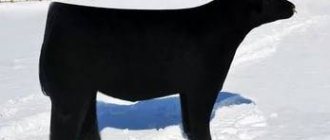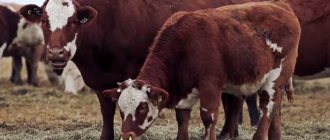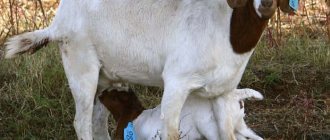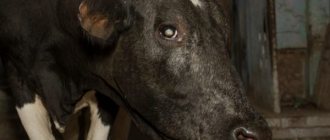Cow's milk - who is it for?
Naturally, it is unlikely that many of us believe that a cow gives milk solely so that a person can consume it for breakfast or dinner. Milk is the only product available to a newborn calf; other food is not suitable for it. The liquid that appears after calving - colostrum - is very important for him, since it ensures that the intestinal tract of the calf is populated with the necessary bacteria. The calf's immunity is strengthened, it begins to grow and develop quickly.
The first days after the calf is born, its diet is limited to 1.5 liters of milk. But subsequently the norms increase and amount to 6 l/day. In this case, an adult cow after calving gives more milk than the baby needs, since milking occurs. Milk is produced due to frequent milking.
Typically a cow is milked up to 5 times daily. This ensures equal intervals between milkings. Therefore, the animal’s body gets used to this regime, believing that it meets the calf’s needs. As a result, cows begin to produce milk after the birth of a calf and the volume of the product constantly grows over the course of 3 months. This time period accounts for about 40% of the productivity of the total volume obtained during the lactation period.
It is important to understand that there is no connection between the fact that a cow eats food and her milk production. The animal produces it regularly from the moment of calving, which is necessary to feed the calf and provide it with the necessary amount of vitamins and nutritional components. Therefore, the cow has milk at any time. If the sucking of a calf is imitated, then milk is produced in the volume necessary to feed the baby.
Important! The cessation of the lactation process occurs during the “launch” period, which begins 30-60 days before calving.
Milk all year round
Video: How long does a cow carry a calf?
After giving birth, you need to monitor the health of the cow regularly and provide her with proper care: milk at the same time, get vaccinations, follow the diet. The quality of milk yield and its volume depend on this.
With proper care, the cow produces milk almost until the next birth. You need to stop milking gradually, 2 months before the baby arrives.
Some cows are milked until calving, stopping giving milk a few days before giving birth. Mostly adult animals do this, although such actions are harmful to health, but leaving the udder with milk, which is regularly collected, is not safe. Mastitis and inflammation are possible.
After giving birth, you need to monitor the health of the cow
After giving birth, about a month later the cow will become restless and moo frequently. If by that time it has already been sent into the herd, then other individuals will react to it. This means that it is time to lead her to a bull or artificially inseminate the cow. If the cow’s body is weakened, it is recommended to isolate it for a day and carry out fertilization in a month.
A cow's pregnancy lasts 9 months, and she does not stop producing milk. It happens that a cow cannot conceive a calf for several months. After 4-5 attempts, you should stop. Such a cow is called barn cow. She can be milked for a long time, but the volume of milk will decrease, so it is better to send her to slaughter.
Note! The period when a cow gives milk depends on the natural processes in her body, and not on the season.
The amount of milk received per milk yield depends on many factors:
- conditions of detention;
- health conditions;
- balanced nutrition;
- compliance with the milking regime;
- walks;
- time of day (morning, lunch, evening);
- mood;
- individual characteristics of the body;
- breed of cow.
The benefits of milk for humans
Dairy cows are kept by humans to produce milk that will be included in the human diet. It, like fermented milk dishes, is priceless for humans, especially children. This is due to the saturation of calcium, vitamins, proteins, carbohydrates, amino acids, fats and protein.
Low-fat, low-calorie milk is included in many diets, and its regular consumption provides:
- prevention of heart and vascular diseases;
- blood cell renewal;
- elimination of symptoms of heartburn;
- restoration of all processes of the functioning of the gastrointestinal tract;
- strengthening the bone structure, hair, nail plates;
- normalization of the nervous system.
In the modern world, manufacturers offer many types of milk - pasteurized, ultra-pasteurized, dry. They differ in processing technology, taste, and richness of nutrients.
However, the greatest benefit comes to the body from fresh milk, which is not subjected to thermal effects, retaining a maximum of valuable components. Although there is a risk of exposure to pathogenic microorganisms. But the quality characteristics of the product are determined by the health of the animal, its nutritional characteristics, breed, and compliance with the rules of caring for it.
Types of milking machines
Machines are classified according to the types of engines installed. They are divided into equipment with a dry engine and an oil engine. The difference is that the blades of a dry motor are made of graphite material, which very quickly becomes unusable, and when it works, it creates a lot of noise. Therefore the price value is very low.
The oil-powered device has blades made of metal material, which move due to special lubricant. There is almost no noise. Durable to use.
The milking machine is classified according to the principle of "smart action" and the characteristics of the working process.
- According to the types of glasses installed, which can include both single- and double-chamber glasses.
- According to the method of milking, use two-act or three-act machines.
- By type of pumps - piston and centrifugal. A pump with pistons can operate without a connected pulsator. It is characterized by its low price and ease of use. A pump based on pulsators works better and produces high-quality milking.
- Milk collection. A household model with a convenient container that can be removed and easily drains the milk. Thanks to advanced production, there are special tubes that can be easily connected to the tank itself.
Features of milk formation
The process of lactation in cattle is quite complex. In a simplified form, milk is produced from the mammary gland. The cells of the organ extract individual substances from the blood and transform them into a specific composition:
- the concentration of sugar in milk increases 90 times compared to blood;
- the proportion of fat increases 20 times;
- the percentage of calcium increases 14 times.
These features confirm the inextricable connection between blood and milk. In fact, blood mass constantly passes through the mammary gland at the rate of 500 liters per 1 liter of milk.
In some cases, the quality and structural characteristics of milk differ depending on the shares of the udder. The reason is the separation of the anterior and posterior lobes of the udder. Therefore, from each of them there is a separate nipple, the number of which is four, and extremely rarely - 6. As a rule, the hindquarters produce a larger volume of milk compared to the forequarters.
If the nipples are stimulated, the hormone prolactin begins to be produced, which promotes the development of the mammary glands and the conversion of colostrum directly into milk. With greater prolactin activity, the volume of milk produced is higher. And with proper regular milking, its normal release is ensured.
Since blood can be considered as the raw material for the formation of cow's milk, we can assume that the entire body takes part in production. For example, the rumen (forestomach) ensures the transformation of acetic acid, which is present in carbohydrates, with special enzymes. This acid is necessary for the formation of milk fat. Alveoli extend from the glandular tissue of the udder. Some of them form fat, while others do not. Mixing occurs in the outgoing channels.
When the udder becomes overfull, milk production stops, and in some cases the nutritional components begin to dissolve. Therefore, it is necessary to ensure regular, uniform milking of the cow throughout the day. Otherwise, this threatens to burn out the body, as a result of which milk yield decreases.
Important! If the interval between milkings is too long, for example, more than 12 hours, udder edema develops. Subsequently, there are risks of inflammation and other pathological disorders.
A little about milk production
In different mammals, the composition and appearance of milk is almost the same. There are only minor differences in the content of microelements and other components produced during lactation. Experts say that the nutritional value of this product is directly related to the food of the animal. So, if bitter herbs predominate in the cattle menu, then the milking product will have the corresponding taste.
Let's take a closer look at how a cow produces milk. You might think that it was formed from the food that is given to her - hay, fodder. However, the dog eats completely differently, and feeds its cubs the same way. Moreover, regardless of the type, size and gastronomic needs, any mammal can produce milk stored in the mammary gland and having a similar composition. Where does it come from?
It turns out that everything is simple: blood is the main raw material for the production of this product. They seem to be completely different substances, but in terms of content they are very close. It turns out that when about 500 liters of blood are processed, only a liter of milk appears in the udder. Imagine how much blood is needed to form the daily norm.
But this does not mean at all that the animal’s nutrition plays absolutely no role, and only blood is needed for milk to appear. Food is the main supplier of vitamins, microelements and nutrients. The healthier and more varied the diet of cattle, the richer the blood and the tastier the cow’s milk.
To find out how a cow produces this product, we need to look at its physiology. This process involves complex chemical reactions involving enzymes. An average of 3.5 liters of blood is pumped through a cow's udder every minute. The mammary gland of mammals contains special cells. With their help, vitamins and other useful substances are taken from the blood, converted into milk and delivered to the udder for further storage. Next, the owner milks the animal.
When does a cow give first milk?
On average, the age of a young cow when she is ready to bear offspring is 1.5 years. From this time on, she can already participate in the first mating with the male. If fertilization occurs successfully, after 9 months. the animal calves. In this case, the following features must be taken into account:
- The production of milk by a cow begins after the first birth. Therefore, taking into account the age at which insemination occurred, she will be milked from 2.8-2.9 years of age.
- The young cow has not been milked before, so it is necessary to ensure contact of the calf with her udder as quickly as possible. This will allow you to quickly milk the udder. Sucking by the baby helps to develop the mammary gland, and in the future will ensure high productivity.
- Lactation, which started after the first calving, will continue in the event of a second pregnancy. This can happen within 2-3 months. Such milk can be safely used by humans as a food product.
- In the absence of re-fertilization, milk is produced, but milk production gradually decreases. Farmers call such a cow a barn cow. Without re-calving, the milk will soon disappear, and a new lactation will require waiting for another fertilization.
- Maximum lactation productivity is achieved at the age of six years. After this milestone, production volume begins to decline.
The first milking after childbirth is accompanied by the release of yellow milk, characterized by increased fat content. This is colostrum, which is a means of adapting the calf to living conditions outside the mother's body. You will not be able to boil this kind of milk; it will quickly curdle under the influence of elevated temperatures.
Unlike standard cow's milk, colostrum is rich in keratin. Therefore, immediately after milking, the product is similar in taste to cottage cheese, and the taste has notes of milk after boiling.
Measures for good milk production
The fullest possible milk output from the udder is desirable not only for reasons of economic benefit. If the nutrient stagnates in the mammary gland, this can seriously affect the health of the cow, causing mastitis or a number of other udder diseases.
In the first week after calving, the main condition for high-quality milk production is the regular access of the calf to the mother. During milking, the cow may instinctively leave some of the milk for the baby. And constant feeding of the calf's udder will teach the cow to produce milk more fully.
The following points can also hinder maximum milk yield:
- loud noise near the room where milking is carried out;
- pushing, shouting and careless handling of the animal;
- frequent changes of milkmaids who work with the cow;
- irregular milking.
It is worth noting that even the use of milking machines can cause a decrease in milk production. This is especially true for cows whose udders are too sensitive.
But in the case of manual milking, you should also adhere to a clear technology for implementing the procedure. This will enhance the formation and release of milk without harm to the animal. This procedure is carried out as follows:
- The udder is massaged for 60-90 seconds.
- Milk is given out, preferably after first milking a couple of streams (to avoid infection).
- The final massage and milking of the cow is carried out.
Important! In the first days after calving, the cow needs to be milked at least 4-5 times a day. It is necessary to reduce the frequency of the procedure up to 3 times as milk formation decreases.
What affects the quality of milk?
Since the basis for milk production is blood, the quality of nutrition significantly affects the characteristics of the product. After all, it is food that contributes to the appearance of useful substances and vitamins in the blood. A balanced and varied diet ensures the production of a tasty product as a result of lactation.
Of course, milk will begin to increase, even without eating. However, the lack of feed or its low quality will affect the characteristics of the milk and the productivity of the animal. That is why for the best milk yield, regular feeding with hay, fresh grass, mixed feed, root vegetables, cake and other useful food ingredients is required.
The following factors influence the dairy productivity of cattle and the quality of milk:
- conditions for keeping the animal, compliance with all hygiene rules;
- the cow's immunity and state of health;
- balanced and regular diet, quality of food and feed;
- compliance with the frequency of milking;
- ensuring timely walking, creating the most favorable conditions in the pasture;
- specific time of day when milking is carried out (morning, lunch, evening);
- emotional state of the animal - stressful situations should be excluded;
- individual characteristics of the body of cattle;
- Burenka breeds.
An interesting fact is that in the case of calving in winter, milk production is approximately 10% higher. The dry period also matters. Usually this time becomes a milestone in the lactation process. Since the cow needs additional strength before giving birth, milk production is inhibited during the dry period. Experts recommend following all recommendations, which will increase productivity.
Under natural conditions, the cow herself will begin to drive away her calf in the event of a new pregnancy. At the same time, milk acquires bitter notes over time, because the body gradually prepares for childbirth.
Under normal conditions, calving occurs once every 1 year. Therefore, on a farm, milk production is maintained over a 10-month period of the year. However, experienced farmers manage to extend this period to 2 years. True, the absence of a new pregnancy entails a gradual decrease in milk production.
Average milk yield
The average productivity in the summer is 15-20 liters of milk.
The amount of product obtained from a cow directly depends on age. The most favorable age period lasts from 4 to 7 years.
After 7 years, the amount of milk production gradually decreases , since the cow’s body cannot fully renew its vitamin reserves.
Breed is important. There are specially bred varieties: Holstein, Black-and-White or Yaroslavl dairy breeds. Such individuals produce a large amount of product. On average, up to 5000 liters per year are obtained from a purebred cow. This indicator is derived based on daily and monthly calculations.
Average cow milk per day
The average daily milk yield varies from 10 to 17 liters for representatives of meat and dairy breeds.
Average monthly milk yield
The amount of monthly milk yield cannot be calculated accurately; it depends on many external factors: nutrition, health status, calving period, habitat area.
Milk yield rates vary from country to country. The leader in terms of monthly milk yield is Israel, where female cattle produce 1,700 liters of milk.
Be sure to read:
Milking machine for cows at home, operating principle of AID-2, instructions
In European countries, animals produce from 500 to 700 liters, in America and Canada the figures are at the level of 700-800 liters. In England, the average individual produces up to 700 liters of product over four weeks.
Russia and Ukraine lag behind in terms of indicators ; in these countries, average milk yield is in the range of 200-400 liters of milk per four weeks.
How much milk can you get in a year?
The highest global annual milk yields are in America, Denmark and Israel, where they receive 8-12 thousand liters of milk from cattle.
In the vastness of Russia, the average figures for ordinary cows reach 5000 liters, and for dairy cows - 8000 liters per year. Holstein cows can produce over 10,000 liters. Some farmers receive about 12,000 liters of product from purebred individuals.
Problems of low milk and dairy-free
Many farmers are faced with a number of diseases that provoke low milk production and milklessness - hypogalactia and agalactia, respectively. They are a consequence of various external factors and changes that the animal’s body undergoes. Signs of the disease appear not only after the onset of lactation, but also before it. There are several types of illness:
- stern;
- artificial;
- climatic;
- operational;
- physiological;
- deposition pathology.
If feed agalactia occurs, then the cow’s body is faced with a deficiency of useful components - vitamins, proteins, minerals. To eliminate the problem, you will need to organize balanced feeding and adhere to a strict food supply schedule. But the artificial type of agalactia is caused by incorrect human actions - changing the regime of keeping the animal, changing the diet, etc. Therefore, any changes should be gradual, for example, changing food, environment, personnel, which will eliminate the manifestation of stress.
Pathology caused by the climatic factor is due to changes in weather conditions, temperature and living conditions. To eliminate problems with health and milk production, it is necessary to keep the cow in a clean, warm, well-ventilated room, but without drafts.
When grazing on pasture, it is important to prevent the animal from overheating in the open space. If a cow is negatively affected by physiological factors, then she may develop agalactia, which leads to udder diseases, gastrointestinal disorders, the appearance of parasites, and general weakness. The consequence is loss of milk. And we should not forget about the need for mobility, the lack of which can provoke loss of milk against the background of other pathologies.
Milk production records
The world's largest milk yield was recorded in Cuba; the cow produced 41,673 liters of product in 12 months. In second place is the milk yield of 31,714 liters, an indicator recorded in the USA.
In Russia, two records were recorded in the amount of 30,869 and 19,670 liters per year, the yield was obtained from individuals of the Yaroslavl and black-and-white breeds. In Canada, the Holstein cow produced 22,324 liters throughout the year.
To choose a cow with good milk yield, you need to take a closer look at the appearance of the animal.
The possible amount of milk is influenced by the following characteristics:
- the female must have strong legs;
- It is better to choose a cow with a small head;
- it is desirable that there are no bulges on the back;
- the stomach should not fall too low;
- the individual must have a round udder with healthy skin.
Be sure to read:
At what age do chickens begin to lay eggs: up to what age, what does it depend on, why do they stop
Do not forget that large milk yields depend on the correct diet of the calf in the first 6 months of the cow’s life. Read more about this and the reasons in our article: Proper diet for calves in the first six months.
Methods for ensuring milk productivity
In order to successfully engage in dairy farming, you need to implement several important steps:
- choose a healthy cow with strong immunity of the optimal dairy breed;
- create conditions for keeping the animal - prepare a heating system, feeders and drinking bowls, hygiene and cleaning products;
- purchase feed of the required quality and in the required quantity;
- prepare a pasture or place where the cow will graze;
- choose the optimal milking method - manually or using a machine;
- in order to maintain the health of the animal, it is necessary to give it vaccinations in a timely manner, maintain hygiene, and treat the skin against parasites and bloodsuckers;
- carry out anthelmintic prophylaxis every 6-8 months, conduct blood and milk tests annually.
By following these measures, it is possible to create the best conditions for keeping cattle, which is realized in high yields of high-quality and tasty milk.
The production of a dairy product is a very complex process, and therefore farmers have developed many useful solutions and secrets that help increase productivity. Knowledge of the rules for keeping, feeding, and milking an animal is an integral factor in achieving the required milk parameters.
Why can a cow calve late?
There are no objective reasons why a cow does not calve for a long time and walks around. This sometimes happens even in those cows that have always calved consistently on time.
Over many years of practice of keeping high-yielding cows, I also did not notice any pattern between post-term pregnancy and:
- overweight cow;
- multiple pregnancy;
- first calving;
- age of cattle.
The only observation is that sometimes cows carrying a bull walk around.
Another assumption is that the pregnancy period may be delayed by diseases or the condition of the animal’s body.
In order to avoid them, you should properly prepare the cow for calving (create optimal housing conditions and create the correct diet in dry wood).
Example(!): Excess calcium, potassium and phosphorus in the diet before calving (feeding legume hay, chalk, salt, for example) can subsequently cause hypocalcemia and, as a result, lead to paresis. A shortened dry period will not allow the cow to gain strength before giving birth - hence weak pushing, delayed placenta and/or a frail calf.
Useful video on the topic: How to help a cow during childbirth:
How to choose a dairy cow
If you need a cow with good milk yield, which would become a real nurse, then these tips are for you:
- The body of the animal should be slightly elongated, the legs high and strong, and the body flattened
- Light and small head
- The neck is thin with folds
- Slanted ribs and straight back
- Uniform belly that does not hang down to the knee joint
- It is desirable for the udder to be voluminous and smooth without irregularities
- If there are large milk folds on the udder, this is very good.
Choosing a milking machine for cows
Photo source: source
If there are too many cows on a farm, it is very difficult to milk them by hand. Your fingers and muscles will become very tired. In no case should you skip milking, so a special device was developed that does this automatically. It creates the sensation of a calf sucking and milks it into a bucket.
According to the method of suction, devices are divided into two types: vacuum and squeezing. The second one is much better. It creates the sensation of hand milking or suckling a calf. And it practically does not injure the nipples. By the way, all these devices are very noisy. The cow needs time to get used to them. To do this, turn them on during manual milking. How effective the installation is can be judged by the following factors:
- Milking speed and completeness of milking
- How well do glasses stick to nipples?
- Noisiness
The price depends on the type and configuration, but expensive does not always mean high quality.
Secrets of milking a home nurse
Photo source: source
The owner, dressed in clean clothes, with an apron and bucket, enters the pen. Next, he lightly strokes the cow, says kind words to her, rinses the udder with warm water and wipes it with a hard towel. Then massages the udder with light, smooth movements. The cow should relax and her belly should drop. At this moment you can sit near the cow’s leg.
But how to milk so that she gives all her milk? No one should interfere or interfere with the communication between man and animal. Slowly and gently, the hostess begins to milk the cow. The udder should be wiped with a towel, and the nipples should be lubricated with petroleum jelly. After which the cow is petted and given a tasty drink with bran or flour mash. How much milk a cow will give will also depend on contact with the owner.
Having your own cow is very good. If you maintain, feed and care for it correctly, then you will always have fresh and tasty dairy products. And besides, a stable sufficient income from sales of environmentally friendly products. The main thing is that you need to pay enough attention to this, the work should be organized and thoughtful.
Identifying an old cow by its horns, teeth and appearance
- The most optimal and convenient way for a beginner is to determine the number of calvings by the rings on the horns. If more than 6, don’t take it.
Keep in mind that there are cows without horns or with faint rings. They may appear due to problems in the quality of housing not related to calving. In addition, the upper stratum corneum may be torn off, then it will not be possible to see the number of rings at all.
It must be understood that the rings reflect periods of calcium deficiency, and not calving, as such. With balanced content, they may not exist at all. So this method, although popular, cannot be a guaranteed way to determine the age of an animal.
Note(!): If the cow did not cover in any year and was barren, then a ring on the horns will not form, since there was no start. In addition to the number of rings on the horns, consider the distance between them. If a year has been missed, then between adjacent rings it will be wider.
- To determine the age of cattle, the degree of tooth wear can be assessed. This is not the easiest way, you need to be able to do it and have experience (I, for example, don’t know how).
- Another option is to look at the appearance of the cow. As she ages, her udders droop. The cow becomes oily. The muzzle may turn grey, etc.
Note(!): Oils are bones. But oily doesn’t mean bony or skinny. This means that large bones stand out prominently against the muscles, creating the appearance of protruding hinges.
Caring for a cow during pregnancy and after
Use on your websites and blogs or on YouTube adsense traffic auto click bot
The first insemination is an important period that largely determines the milk production of a cow. 2-3 months before pregnancy, the cow stops milking so that she can rest and gain strength. After insemination, the heifer requires proper care and good feeding. If the female continues to give milk, you should change the diet and, if necessary, contact a veterinarian. Lactation begins in the first 24-48 hours after birth, and consists of three periods, each of which has its own characteristics.
- Milking lasts 10-50 days. At this time, there is an increased production of the hormone prolactin, which determines the amount of milk. It is important to milk the cow regularly and well, as nipple stimulation has a beneficial effect on milk production. During morning and evening milking, it is necessary to allow the calf near the heifer - he will milk the heifer better than any milkmaid.
- The main period of milk production lasts several months and allows you to get the maximum amount of milk. A cow requires feed containing all the beneficial substances, vitamins and microelements.
- Milking is stopped 2 months before the next insemination so that the animal’s body has time to recover.
What determines the lifespan of a cow?
Before talking about absolute numbers, let's find out what factors influence the lifespan of this animal. It would seem that everything depends on the conditions of detention, but in fact this is not entirely true.
The lifespan of a cow is determined by:
- Climatic conditions. The comfortable temperature for Bos taurus taurus (Latin name for domestic cow) is +10 °C. The further the temperature readings are from this mark in one direction or another, the faster the animal will exhaust its natural reserve. Cows do not tolerate high humidity and strong winds very well. For example, in the Northwestern regions of Russia, where weather conditions are harsh and vegetation is poor, cattle on average do not live as long as in favorable black earth regions.
- Country (region) of residence. In this case, we are talking not so much about its territorial location, but about the level of development, mentality, method of keeping animals, and intensity of exploitation. If a cow is treated as a sacred animal (modern India, Sri Lanka, Nepal and other states where Hinduism is the dominant religion), the animal has a much better chance of living to old age than where it is exploited and sent to slaughter as soon as productivity begins to decline.
- Ecology. The maximum distance from megacities, industrial facilities and other achievements of civilization significantly increases the lifespan of an animal, so in a remote village a farmer has a much better chance of developing beef and milk production than in a city.
Thus, the life cycle of animals is influenced by both objective and subjective factors.
Dairy product | Britannica
Nutrient composition
Although milk is a liquid and is most often considered a beverage, it contains 12 to 13 percent solids and should arguably be considered a food product. In contrast, many "solid" foods such as tomatoes, carrots and lettuce contain only 6 percent solids.
The composition of milk is influenced by many factors, including breed, genetic makeup of the individual cow, age of the cow, stage of lactation, milking intervals, and certain diseases. Since the last milk taken at each milking is the fattest, the completeness of the milking also affects the sampling. In general, feed type has only a small effect on milk composition, but poor quality or insufficient feed results in both low milk yield and low solids percentage. Modern feeding programs use computer technology to achieve maximum efficiency from each animal.
The composition of milk among mammals varies primarily depending on the growth rates of individual species. Proteins contained in breast milk are the main components influencing the growth rate of young animals. Breast milk contains relatively little protein and minerals compared to the milk of cows and goats.
Goat's milk has approximately the same nutrient composition as cow's milk, but differs in several characteristics. Goat's milk is completely white because all the beta-carotene (from the feed) is converted into vitamin A. The fat globules are smaller in size and therefore remain in suspension, so the cream does not rise and mechanical homogenization is not required. Goat milk curds form small, light flakes that are easier to digest, just like breast milk curds. It is often prescribed to people who are allergic to cow's milk proteins, as well as to some patients with stomach ulcers.
Sheep milk is rich in nutrients and contains 18 percent solids (5.8 percent protein and 6.5 percent fat). Reindeer milk contains the highest level of nutrients, with 36.7 percent solids (10.3 percent protein and 22 percent fat). High in fat and protein, this milk is an excellent ingredient for cheese and other dairy products.
The main components of milk are water, fat, protein, carbohydrates (lactose) and minerals (ash).
However, there are many other very important micronutrients, such as vitamins, essential amino acids and trace elements. In fact, more than 250 chemical compounds have been found in milk. The table shows the composition of fresh liquid milk and other dairy products. Nutritional composition of dairy products (per 100 g)
| dairy | energy (kcal) | water (g) | protein (g) | fat (g) | carbohydrates (g) | cholesterol (mg) | vitamin A (IU) | riboflavin (mg) | calcium (mg) |
| * Enriched with vitamin A. | |||||||||
| **Low humidity, partial degreasing. | |||||||||
| Source: USDA, Food Composition, Agricultural Handbook No. 8-1. | |||||||||
| fresh whole milk | 61 | 88 | 3,29 | 3,34 | 4,66 | 14 | 126 | 0,162 | 119 |
| fresh low-fat milk * | 50 | 89 | 3,33 | 1.92 | 4,80 | 8 | 205 | 0,165 | 122 |
| fresh skim milk * | 35 | 91 | 3,41 | 0,18 | 4,85 | 2 | 204 | 0,140 | 123 |
| condensed milk | 134 | 74 | 6,81 | 7,56 | 10,04 | 29 | 243 | 0,316 | 261 |
| condensed skim milk * | 78 | 79 | 7.55 | 0,20 | 11,35 | 4 | 392 | 0,309 | 290 |
| condensed milk | 321 | 27 | 7,91 | 8,70 | 54,40 | 34 | 328 | 0,416 | 284 |
| skim milk powder * | 358 | 4 | 35,10 | 0,72 | 52,19 | 18 | 2,370 | 1.744 | 1,231 |
| butter | 717 | 16 | 0,85 | 81,11 | 0,06 | 219 | 3 058 | 0,034 | 24 |
| ice cream (vanilla) | 201 | 61 | 3,50 | 11,00 | 23.60 | 44 | 409 | 0,240 | 128 |
| ice milk (vanilla) | 139 | 68 | 3.80 | 4,30 | 22,70 | 14 | 165 | 0,265 | 139 |
| sherbet (orange) | 138 | 66 | 1,10 | 2,00 | 30,40 | 5 | 76 | 0,068 | 54 |
| frozen low-fat yogurt | 128 | 69 | 3,94 | 0,18 | 28,16 | 2 | 7 | 0.265 | 134 |
| buttermilk | 40 | 90 | 3,31 | 0,88 | 4,79 | 4 | 33 | 0,154 | 116 |
| sour cream | 214 | 71 | 3,16 | 20,96 | 4,27 | 44 | 790 | 0,149 | 116 |
| yogurt, plain, low fat | 63 | 85 | 5.25 | 1,55 | 7,04 | 6 | 66 | 0,214 | 183 |
| low-fat fruit yogurt | 102 | 74 | 4,37 | 1.08 | 19,05 | 4 | 46 | 0,178 | 152 |
| blue cheese | 353 | 42 | 21,40 | 28,74 | 2,34 | 75 | 721 | 0.382 | 528 |
| Brie cheese | 334 | 48 | 20,75 | 27,68 | 0,45 | 100 | 667 | 0,520 | 184 |
| Cheddar cheese | 403 | 37 | 24,90 | 33,14 | 1,28 | 105 | 1,059 | 0,375 | 721 |
| cottage cheese | 103 | 79 | 12.49 | 4,51 | 2,68 | 15 | 163 | 0,163 | 60 |
| cream cheese | 349 | 54 | 7,55 | 34,87 | 2,66 | 110 | 1,427 | 0,197 | 80 |
| mozzarella cheese ** | 280 | 49 | 27,47 | 17,12 | 3,14 | 54 | 628 | 0.343 | 731 |
| Grated Parmesan cheese | 456 | 18 | 41,56 | 30,02 | 3,74 | 79 | 701 | 0,386 | 1,376 |
| Emmentaler (Swiss) cheese | 376 | 37 | 28,43 | 27,54 | 3,38 | 92 | 845 | 0,365 | 961 |
Why does a cow give milk to a person?
A cow is a mammal, which means that after birth, the calf at the beginning of its life will feed on milk from its udder. In nature, the calf feeds uncontrollably from the heifer until nine to ten months. On farms, babies must be separated from their mother immediately so as not to create a stressful situation for the animals later.
Next, the cow must be milked by hand, feeding part of the milk to the baby, the rest can be used for food and for preparing dairy products for humans. The calf continues to be fed for 3-4 months, gradually transferring it to the usual food of large horned animals. You should strive to milk the cow for as long as possible, until she becomes pregnant again, that is, becomes pregnant. During this period, milking stops for two months.
Read also Seeds of vegetable and flower crops Aelita agricultural company
Now let's explain why you can't milk a cow for too long. As a rule, an animal calves once a year, therefore, it can produce milk for an average of ten months. If the heifer remains dry, that is, does not become pregnant, milking can be extended for up to two years, but the quantity and quality of the product will decrease.
What age is the best cow to buy?
A purebred or local high-yielding cow (from 25 liters of milk from calving) fully pays for itself in a year.
If the buyer seriously intends to receive income from dairy products for the maximum number of years, then he should take an animal no older than the 2nd-4th lactation. However, the cost of a young cow will be higher.
In practice, cattle older than the sixth lactation are no longer popular and are cheaper. This is a good option for those who need one cow for personal needs and do not require a large amount of milk, the main thing is that they have an easy-going character.
Example(!): The cost of a milk cow can be very different - 60-120 thousand rubles. and higher. For example, a cow that costs 80 thousand before the 6th lactation will cost no more than 65-70 thousand after the 6th lactation, and 40-45 thousand after the 8th-9th lactation (at the price of meat).
If we are talking about a highly productive cow, especially a purebred one, then for many this is the only financially feasible option to obtain this blood. That is, in the future, get a heifer from this cow for reproduction. Because there is still the possibility of 2-4 pregnancies in the future.
Read about how to choose a good heifer in a separate article on moikorovu.ru.
Calving problems
For new farmers, the most common questions that arise are about fertilization and reproduction. If the main goal is breeding, then the animal is prepared for this from birth, and is provided with special maintenance and care. On forums and agricultural websites you can often find questions about what to do: the cow has calved, but there is no milk. The reasons can be very different - from abnormal nipple structure to inflammation of the udder (mastitis).
Usually, if all rules and regulations are followed, such problems do not arise. Conscientious owners must provide the animal with comfortable conditions before and after birth:
- How do you know when a cow will calve? This can be seen from several signs: she tries to retire, to get away from the herd. Therefore, it is best if the cow is given a separate stall, cleaned and covered with fresh bedding.
- The place where the cow will calve must be dry and free of foreign objects.
- If she is in a large room with automatic manure removal devices, care must be taken that the animal does not walk along the aisle, otherwise the calf may get caught in such a scraper.
- Provide a balanced diet and plenty of fluids, in addition to this, owners often add multivitamins and microelements to the regular diet.
Every farmer must understand that childbirth is extremely stressful for an animal, so a cow requires increased attention and care.
Feeding dairy cows
The formation of milk is a complex and energy-consuming process that requires proper nutrition. Feed consumption is calculated depending on the live weight of the animal, and the composition should be varied. One of the main components of milk is protein, so it must be contained in sufficient quantities in the feed.
In addition, the diet should include roughage (in lower concentrations than for barn heifers), as well as products to increase milk production. These are juicy and green food, as well as root vegetables - primarily potatoes and beets, as well as pumpkin, rutabaga, and turnips. The required components include salt - at least 4 g per liter of milk. Walking dairy cows in the summer is mandatory - with fresh grass, animals receive 65% of all the substances necessary for the body.
It is not recommended to feed a dairy cow concentrated feeds, as they contain few nutrients and can have a negative effect on the animal's body. Concentrates are administered in small quantities to increase the fat content of milk. The cow's diet should be changed every two months, but new feeds should be introduced gradually, monitoring the body's reaction. It is important to give cows plenty of water at room temperature.











